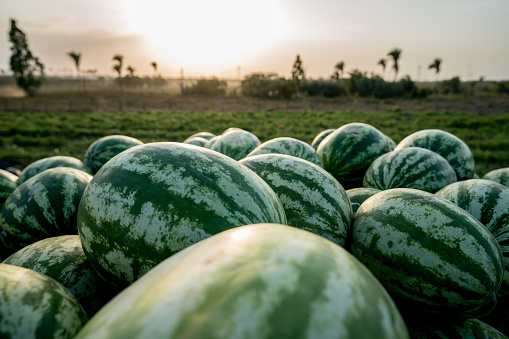
Produce 101: Melons
Dan talks to us today about Produce 101: Melons
Throughout the season many varieties of melon are available—especially during the summer. Today we are going to just focus on the most popular: cantaloupe, honeydew, and watermelon.
Few things are as delicious as perfectly ripe melon, but the challenge is how do you pick the perfect one?

Produce 101: Melons – Selecting a Great Melon
Look for melons that are heavy for their size and free from bruising and defects. Once picked, a melon’s sugar is set and won’t develop any additional sugar—though a cantaloupe will soften a bit when allowed to sit out. But they do not get riper.
Press gently on the stem end and it should give to gentle pressure. Smell the flower end and look for a sweet, melon aroma. The nose knows. When a melon is grown and allowed to fully mature, they will emit a sweet, almost floral aroma, signaling you that an incredible gastronomic experience awaits.
Watermelons are a little different, as they really don’t have a tell-tale aroma, but they do have a revealing spot. Look for watermelons with a large yellow spot, this indicates the watermelon was left on the vine longer and allowed to mature, if you see it you know you will be duly rewarded.

The old adage of thumping a watermelon is not the best way to select a melon, but it does work sometimes.
Keep in mind that during certain times of the year—mainly when heavy rains have occurred, you may see hollow heart. Hollow heart is where the center of the melon splits, thus the hollow sound when thumped, so that really is not a great way to select a melon.

Produce 101: Melons – Storage
All melons are susceptible to chill damage, but the cantaloupes can be stored at colder temperatures than honeydews or watermelons. Cantaloupes also produce ethylene, and honeydews and watermelons are both ethylene sensitive, so keep them apart in storage.

Cantaloupe tips:
- They like to be colder than the other two. Keep them in in the back (location 1)
- They don’t like temperature fluctuations. While it won’t hurt them, it may cause the flesh to deteriorate and become mealy.
- They easily damage when handled roughly, so avoid dropping the cases or stacking too much weight on top.
- They produce ethylene. Keep them away from sensitive items.
Honeydew and Watermelon Tips
- They are not as sensitive to chill damage, like cantaloupe. They like it a little warmer, keep them in the middle (location 2).
- Honeydews and watermelons are both ethylene sensitive, so keep them apart in storage to prolong their respective shelf lives.

Produce 101: Melons — What is Brix?
Aside from the physical appearance grading, the USDA also adds an internal testing component called “Brix” measurement. Brix is the measurement of sugar crystals in the water content in fruit. It is done with a refractometer.

A few drops of juice are applied to the glass and then viewed through the eyepiece to read the measurement.
Brix measurement is not just used for melons, winemakers use it to test their grapes, and it is also used to check the sweetness in other items, like honey.
Brix gives us a good baseline on how long that fruit was allowed to ripen and if the melon is ready to eat. Depending on the variety, the typical Brix of melons should start around 10-11%, where 14% would be quite sweet for most palates.
The higher the number, the sweeter the melon. Good to know: A higher number doesn’t always mean better. Too high a Brix and it’s just too sweet, as well as the flesh can be mealy.
We have a great article you can read here on understanding Brix and if a higher number is always better.

Produce 101: Melons – Grades
The USDA has multiple grade specs based on both external and internal factors (ripeness). Internally is Brix, discussed above. Externally is grades, see below.
Cantaloupe Grades
- US Fancy
- US #1
- US Commercial
- US #2
Honeydew Grades
- US#1
- US Commercial
- US #2
Watermelon Grades
- US Fancy
- US #1
- US #2
Look for melons that are free from pitting/bruising and have appropriate varietal shell color.
Produce 101: Melons – Tips for Use
Melons can be used in myriad of applications, both sweet and savory. Consider using items that are slightly salty for an amazing contrast to the sweet melon, such as the classic dish of prosciutto and melon.

Dan discusses Produce 101: Melons
Contact your Marketing Associate about adding melons to your next order. If you are not a customer, find out how to become one today!
Content provided by Chef Daniel Snowden, the Director of Culinary Development for FreshPoint Central Florida. He has been in the produce industry almost 20 years, and loves getting geeky about food. Additional contributions by Lisa Pettineo.
Some tools you can use:
Visit freshpoint.com for our seasonal availability guides—and while you are there, check out the FreshPress, our latest market report. Place your orders online with ease at myfreshpoint.com. Did you know you can receive real-time reliable delivery alerts on the day of your delivery? Activate and subscribe at FreshPoint.com/mydelivery
Download our app and take your produce management on the go. Place orders, review flyers, watch videos…all in one spot!
Find out more details about our UBU program, and how we are shining a spotlight on food waste while making value and food safety a priority.
We buy local to strengthen regional economies, support family farms, preserve the local landscape, and to provide fresh-from-the-farm food to our customers. Local.freshpoint.com connects you to your local farmers like never before! Customize your search by zip, city, state, radius…even by crops and growing methods. Pop in your zip code and learn about our local farmers.
Socialize with us!
Did you know we are on YouTube? Head over to our page and check out our 75+ videos. Don’t forget to subscribe, and also be a part of our Bell Team—hit the little bell icon to get notifications when we upload new videos.
Follow FreshPoint, Inc. on Facebook, Twitter, Instagram, and LinkedIn…and follow The Produce Hunter on Instagram as she finds the best specialty produce at the Santa Monica Farmers Market.

